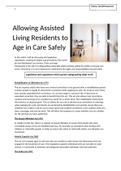Name: Zae12Mcmorrow
1
Allowing Assisted
Living Residents to
Age in Care Safely
In this article I will be discussing the legislation,
regulations, working strategies and procedures that under
pin the Residential Care Homes. There are legal
frameworks in the UK, for safeguarding vulnerable adults working within the public or private care
sector. Therefore, it is very important to understand the rights and responsibilities towards them.
Legislation and regulations which govern safeguarding adult work
Rehabilitation of Offenders Act 1974
This act requires adults who have any criminal convictions to be ignored after a rehabilitation period.
It allows people to legally lie about their convictions while applying for jobs, for instance only if they
have already expended their convictions. So, at some stage in a person's life, if they have an
expended conviction, they are able to benefit from this act. This act also allows most convictions,
cautions and warnings to be considered as spent for a certain time. This rehabilitation determines
the sentence or disposal given. This act allows for you not to disclose your convictions or warnings
when applying for a job. Not all jobs are protected by Rehabilitation Act and this means that your
employer has a right to ask for you to share spent and unspent convictions, even cautions when you
were a teenager and now an adult. This will allow the employer to assess whether you are suitable
for the job that you have applied for.
The Sexual Offenders Act 1976
In relation to this law, there is a register of sexual offenders to ensure that people who have
committed sexual crimes are identified and may, for example, be exempted when dealing with
children or vulnerable people. In order to ensure the safety of vulnerable adults, sex offenders are
monitored.
Mental Capacity Act 2005
This act is for people aged 16 and over who are unable to make choices for themselves that are
engaged in the treatment of care. This regulation supports individuals who are not able to make
choices. It is intended to motivate and safeguard vulnerable individuals who lack potential.
The Police Act 1997
, 2
Under this act comes the Criminal Record Bureau. Within schools and health care settings, such as a
care home, the CRB check is conducted. This is to make sure that individuals want to come and work
for the company or want to get involved. To decide if the person is willing to work with children or
older adults, they need to ensure that they have a CRB check. A CRB is a record of the criminal
operations of an individual. The company must know if you are willing to work adequately with
vulnerable people.
National minimum standards and the care homes regulations 2003
The minimum care that a person should receive in a care home is defined by this act. It also sets the
absolute minimum requirements that could be required by older people in care homes. This act
therefore ensures that carers have the care that is required of them. For instance, a caregiver can be
required to bathe and feed a person. Therefore, as a minimum obligation to meet the needs of the
client, a carer must do both things.
Equality Act 2010
Anti-discriminatory practice is prime to the moral basis of care provision and demanding to the
protection of people's dignity. (scie.org.uk) The Equality Act protects those receiving care and also
the workers that provide it from being treated unfairly due to any characteristics that are protected
under the legislation. The ‘protected characteristics’ are:
Age
Race
Religion and beliefs
Disability
Sex
Sexual orientation
Marriage and civil partnership
Direct discrimination occurs when, for example, someone is treated less favourably than an
individual in similar circumstances on the grounds of a protected characteristic. Indirect
discrimination occurs when a condition or requirement is applied equally to all, but some are unable
to comply because of a protected characteristic, e.g., in a care home. (scie.org.uk) This would be
unlawful unless the condition or requirement is objectively justified. (scie.org.uk)
Strategies and procedures used in health and social care to reduce the risk of
abuse
Safeguarding Vulnerable Act 2006
The aim of the law in relation to Safeguarding Vulnerable Group Act 2006 is to ensure that that
people who may have a criminal background in relation to abusing or exploiting vulnerable people
are checked and out when they apply for a job to ensure their suitability. Nevertheless, vulnerable
people are unable to protect themselves against others and a system is set up to check and vet
regulated workplaces. The aim is to prevent any abuse in the future by anyone that has been
convicted of any offence in relation to abuse. The legislation stipulates that anyone caring for a
vulnerable person should be protected. In addition, it is implemented through a policy that monitors
individuals who seek access to them through their paid, employment, unpaid and voluntary access.
However, under the vetting and barring system, they will have to register and can be tested against





